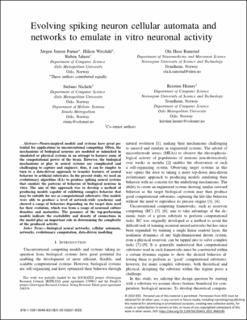Evolving spiking neuron cellular automata and networks to emulate in vitro neuronal activity
Jensen Farner, Jørgen; Weydahl, Håkon; Jahren, Ruben; Huse Ramstad, Ola; Nichele, Stefano; Heiney, Kristine Anne
Conference object
Published version
Permanent lenke
https://hdl.handle.net/11250/2978468Utgivelsesdato
2021-01-24Metadata
Vis full innførselSamlinger
Originalversjon
https://doi.org/10.1109/SSCI50451.2021.9660185Sammendrag
Neuro-inspired models and systems have great potential for applications in unconventional computing. Often, the mechanisms of biological neurons are modeled or mimicked in simulated or physical systems in an attempt to harness some of the computational power of the brain. However, the biological mechanisms at play in neural systems are complicated and challenging to capture and engineer; thus, it can be simpler to turn to a data-driven approach to transfer features of neural behavior to artificial substrates. In the present study, we used an evolutionary algorithm to produce spiking neural systems that emulate the patterns of behavior of biological neurons in vitro. The aim of this approach was to develop a method of producing models capable of exhibiting complex behavior that may be suitable for use as computational substrates. Our models were able to produce a level of network-wide synchrony and showed a range of behaviors depending on the target data used for their evolution, which was from a range of neuronal culture densities and maturities. The genomes of the top-performing models indicate the excitability and density of connections in the model play an important role in determining the complexity of the produced activity.
